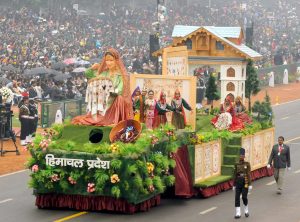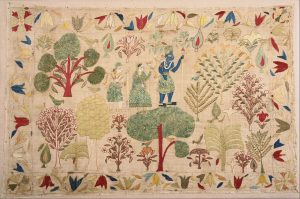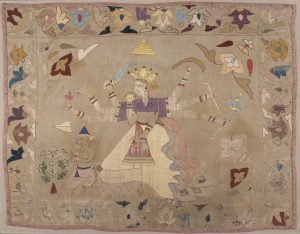Chamba Rumal design also was known by the alternative name of Chamba Handkerchief. A well-known handicraft from the Indian state of Himachal Pradesh. An embroidery work is done in detailed on the rumal.
It is an embroidered handicraft that was once promoted under the patronage of the former rulers of Chamba kingdom. It is a common item of gift during marriages with detailed patterns in bright and pleasing color schemes.
Chamba Rumal Design
This product has been registered for protection under the Geographical indication of the Trade Related Intellectual Property Rights (TRIPS) agreement. On 22 January 2007, it was listed as “Chamba Rumal” under the GI Act 1999 of the Government of India with registration confirmed by the Controller General of Patents Designs and Trademarks under Classes 24 as Textile and Textile Goods, vide application number 79.
Chamba Rumal is used as a ceremonial cover The first form of this rumal is the one made by Bebe Nanki, sister of Guru Nanak in the 16th century, which is now preserved in the Gurudwara at Hoshiarpur.
The Victoria Albert Museum, London has a rumal which was gifted to the British in 1883 by Raja Gopal Singh and it has an embroidered scene of the Kurukshetra War of the epic Mahabharata.

From the 17th century the women of the erstwhile princely state of Chamba (now part of Himachal Pradesh), including members of the royal family, indulged in the embroidery of the rumals or handkerchiefs as a part of a marriage gifts or dowry to their daughters.
The handkerchiefs were made in geometrical shapes of square and rectangle using very fine handmade silk which was obtained from the Punjab or muslin cloth, a product of Bengal. Women created highly ornamental patterns using untwined thread made of silk produced in Sialkot (in Pakistan), Amritsar and Ludhiana.
The embroidery technique adopted, called the dohara tanka or double satin stitch, created distinct identical patterns on both faces of the fabric, which were attractive when viewed even from distance of 10 ft and more. The dohara tanka method is a heritage of Kashmir, which was adopted in Basohli and Chamba, but was improved upon by adopting themes from the special Mughal art of Chamba miniature paintings; this art form flourished during the 18th and 19th centuries.

These artists drew the outlines of the design on the fabric to be embroidered using fine charcoal and also suggested suitable colours to be adopted on the mythological themes of Krishna‘s Raas-Leela of the epic Mahabharata, and themes from Ramayana or scenes of marriage and game hunting to be embroidered; themes also included events from Gita Govinda, Bhagavata Purana or only Radha-Krishna and Shiva–Parvati. Inspiration was also provided from the frescoes done in the Rang Mahal of Chamba.
Following Indian Independence, this artwork lost its royal patronage, and quality deteriorated due to commercialization by making many cheaper varieties such as tablecloths, cushion covers, clothing, and even various machine made items to compete in the market with cheaper similar work from other regions.
Known as a “needle wonder” Chamba Rumal is now made in square and rectangular shapes. The materials used still consist of muslin, malmal, khaddar (a coarse fabric), fine charcoal or brush, and silk threads without knots.
Using a double satin stitch for the embroidery, both faces of the cloth are concurrently stitched by a forward and backward technique to maintain uniformity of design on both faces of the rumal. After completing the embroidery, the fabric is stitched with a border of about 2 to 4 inches on all sides.



